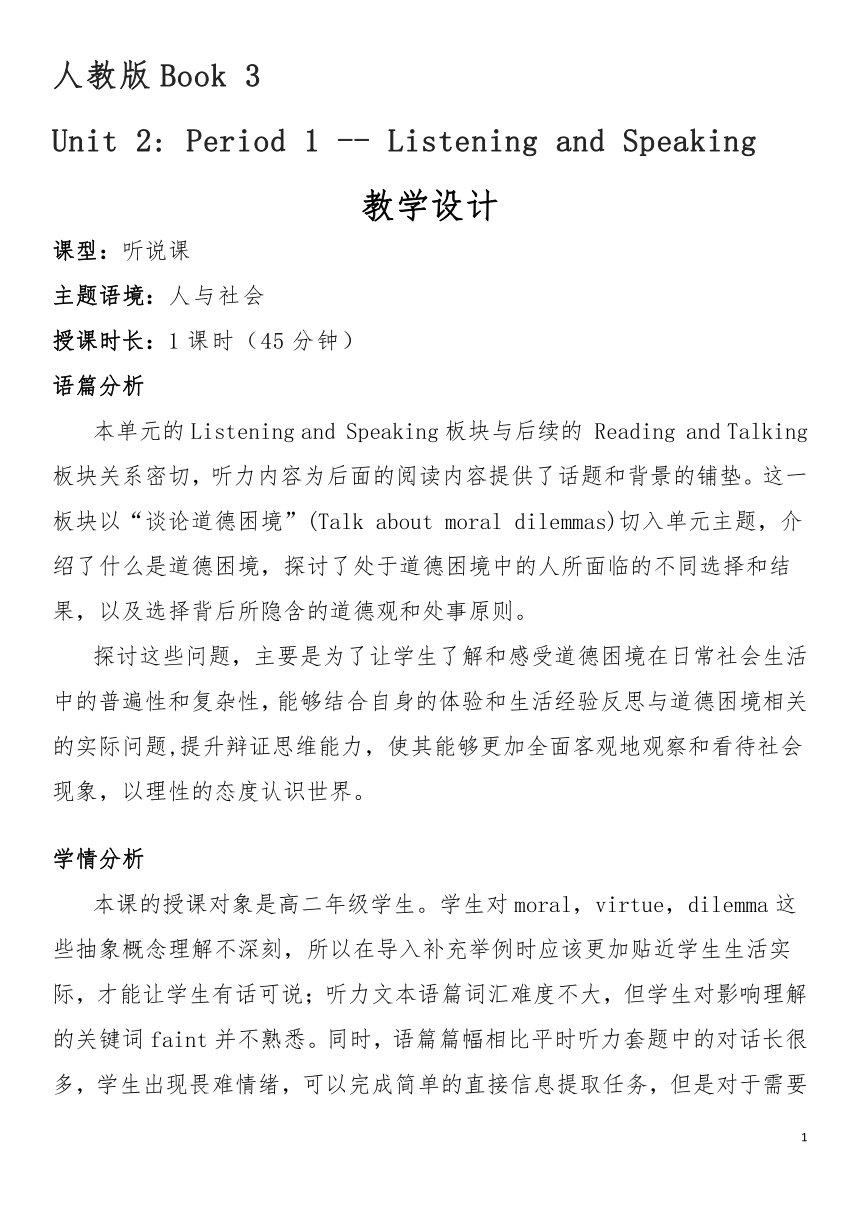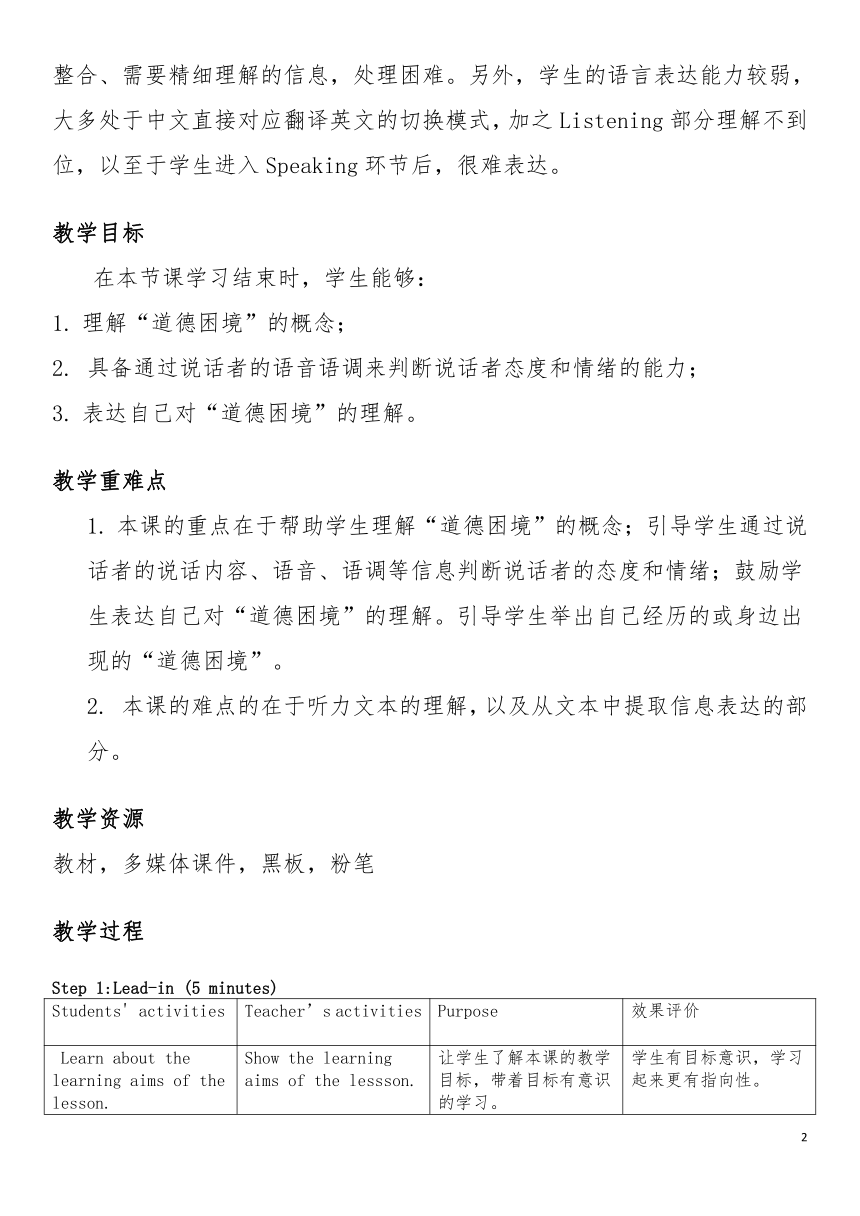人教版(2019)必修 第三册>Unit 2 Morals and Virtues Listening and Speaking教学设计(表格式)
文档属性
| 名称 | 人教版(2019)必修 第三册>Unit 2 Morals and Virtues Listening and Speaking教学设计(表格式) |  | |
| 格式 | docx | ||
| 文件大小 | 306.6KB | ||
| 资源类型 | 教案 | ||
| 版本资源 | 人教版(2019) | ||
| 科目 | 英语 | ||
| 更新时间 | 2023-10-27 14:29:18 | ||
图片预览


文档简介
人教版Book 3
Unit 2: Period 1 -- Listening and Speaking
教学设计
课型:听说课
主题语境:人与社会
授课时长:1课时(45分钟)
语篇分析
本单元的Listening and Speaking板块与后续的 Reading and Talking板块关系密切,听力内容为后面的阅读内容提供了话题和背景的铺垫。这一板块以“谈论道德困境”(Talk about moral dilemmas)切入单元主题,介绍了什么是道德困境,探讨了处于道德困境中的人所面临的不同选择和结果,以及选择背后所隐含的道德观和处事原则。
探讨这些问题,主要是为了让学生了解和感受道德困境在日常社会生活中的普遍性和复杂性,能够结合自身的体验和生活经验反思与道德困境相关的实际问题,提升辩证思维能力,使其能够更加全面客观地观察和看待社会现象,以理性的态度认识世界。
学情分析
本课的授课对象是高二年级学生。学生对moral,virtue,dilemma这些抽象概念理解不深刻,所以在导入补充举例时应该更加贴近学生生活实际,才能让学生有话可说;听力文本语篇词汇难度不大,但学生对影响理解的关键词faint并不熟悉。同时,语篇篇幅相比平时听力套题中的对话长很多,学生出现畏难情绪,可以完成简单的直接信息提取任务,但是对于需要整合、需要精细理解的信息,处理困难。另外,学生的语言表达能力较弱,大多处于中文直接对应翻译英文的切换模式,加之Listening部分理解不到位,以至于学生进入Speaking环节后,很难表达。
教学目标
在本节课学习结束时,学生能够:
1. 理解“道德困境”的概念;
2. 具备通过说话者的语音语调来判断说话者态度和情绪的能力;
3. 表达自己对“道德困境”的理解。
教学重难点
1. 本课的重点在于帮助学生理解“道德困境”的概念;引导学生通过说话者的说话内容、语音、语调等信息判断说话者的态度和情绪;鼓励学生表达自己对“道德困境”的理解。引导学生举出自己经历的或身边出现的“道德困境”。
2. 本课的难点的在于听力文本的理解,以及从文本中提取信息表达的部分。
教学资源
教材,多媒体课件,黑板,粉笔
教学过程
Step 1:Lead-in (5 minutes)
Students' activities Teacher’s activities Purpose 效果评价
Learn about the learning aims of the lesson. Understand the title of the unit;Appreciate the quotation and learn about the author——William Wordsworth. Observe the topic picture and answer the question: What qualities are needed when doing teamwork Show the learning aims of the lessson. Explain the meaning of the title and the quotation written by William Wordsworth. Get the students to brainstorm a list of nouns and adjectives related to qualities that are demanded in a team. 让学生了解本课的教学目标,带着目标有意识的学习。 通过解释morals和virtue的概念,找出kindness的共性,引出华兹华斯的名句,进而介绍华兹华斯,并为听后欣赏华兹华斯的名作《致水仙》作铺垫。 熟悉用以描写优秀道德品质的词汇,熟悉句式In my view, a good team demands_____. 学生有目标意识,学习起来更有指向性。 层层递进,首尾呼应。引出道德的核心是善良和爱。 关于优秀品质的词汇,学生储备较丰富。用Brainstorm的方式能有效调动学生参与的热情,从说单词和简单句开始,为后面的表达自我观点做准备。
Step 2:Before listening (10 minutes)
Students’ activities Teacher’s activities Purpose 效果评价
Watch the video and express their feelings and thoughts. Observe the picture and describe the situation, and then discuss with the partner about the moral dilemmas in their life. Play the video and explain the definition of “moral dilemmas”. Encourage the students to describe the picture and give other examples about moral dilemmas. 通过视频内容,直观介绍“道德困境”,引发思考“如果是我,我怎么办?”“什么是道德困境?”的问题。 观察图片,描述图片中的情景,并分析出两种选择可能产生的结果,进一步理解“道德困境”的概念。 视频中呈现的是典型的道德困境,直击主题,引发思考。 学生能快速分析出图片中的情景,深化了对道德困境的理解,但语言表述身边道德困境的例子还是有困难。
Step 3:While listening (15 minutes)
Students’ activities Teacher’s activities Purpose 效果评价
Listen for the first time and fill in the blanks. Listen for the second time and fill in the table. Listen for the third time and mark true(T) or false(F). Listen for the fourth time and answer the following questions. Play the audio and ask the students to focus on the main idea. Play the audio one part after another and guide the students to finish the table. Play the audio again and offer the tips “Listen for attitudes” to the students. Play the video and guide the students to answer the questions. 引导学生听大意,捕捉对话中出现的人物信息。 为了降低难度,老师将听力文本拆分成三个部分,分段播放,引导学生获取细节信息。 引导学生通过语音语调听出说话人的观点和态度。 通过解答问题,进一步的理解文本。 任务设置从易到难,由泛到精,以树立学生的信心。学生完成度高。 前两部分的细节理解属于直接获取信息,学生完成较好。第三部分,需要对两种选择可能产生的结果做出整合概括,学生感到有压力。 通过听力微技能的渗透,学生更多的把注意力放到说话人的语音语调上,帮助理解说话人的态度。带着问题听更有目的性,也为reading部分学习林巧稚的故事做准备。
Step 4: After listening (15minutes)
Students’ activities Teacher’s activities Purpose 效果评价
Read the scripts of the audio. Group work.Discuss what the students would do if they were ever faced with the same situation as the girl.Then make a pare LIn Qiaozhi to daffodil and appreciate the poem”The Daffodils”written by William Wordsworth. Show the scripts. Guide the students to make a dialogue with the useful expressions to convey thoughts and feelings. Explain the flower symbolic meanings of daffodil and relate it to Lin Qiaozhi. Invite Jin Mei, a student in the class who pronouns well, to read the poem. 让学生听后读文本,填补听力理解时的漏洞,帮助巩固听力所得知识。 引导学生讨论,如遇到相同处境,如何处理。在交流处学习表达自己的观点。 通过把林巧稚比作水仙,进一步突出林巧稚的优秀品质。共赏金同学优美的语音语调,激发同学们向她学习,努力练习发音的热情。 学生在通读前,提醒学生关注老师事先标注的关键点,培养阅读和听读抓取关键信息的能力。 学生熟悉说出自己观点的各种表达法,也将听力理解过程中内化的知识运用于表达中。 用华兹华斯的诗歌作为结束,首尾呼应。但由于朗读的音乐背景音过高,导致金同学的声音被掩盖,没有达到预期的效果。
Step 5: Homework
Students’ activities Teacher’s activities Purpose 效果评价
Imitate Jin to read the poem and pay attention to the pronunciation. Surf the Internet to find more information about Lin Qiaozhi. 练习语音语调,反过来有助于听力理解能力的提升。进一步了解林巧稚,为下一课的阅读做准备。
板书设计
教学反思
闪光点:
1. 结合学生实际,对听力录音进行拆分处理,降低难度,符合学情。
2. 把林巧稚比作水仙花的设计属于教材外的拓展,也是创新行为。使学生学习了英国诗人华兹华斯的文化知识,水仙花的花语突出了林巧稚的优秀品质,使同学们印象深刻。
不足之处:
1. Lead-in部分的衔接欠流畅。
2. 鼓励学生说出自己的观点和态度的任务,未能很好的达成。学生表达出现困难时,作为老师,容易着急替代,这样剥脱了学生表达的机会。鼓励学生“说”的准备工作不到位,时间也不够充分。
3. 邀请班级中语音语调优秀的同学作展示,树立榜样的力量,激发同学们练习发音的热情。这一想法和好,但是实施的过程中没有顾及客观因素,导致效果没出来。
Unit 2: Period 1 -- Listening and Speaking
教学设计
课型:听说课
主题语境:人与社会
授课时长:1课时(45分钟)
语篇分析
本单元的Listening and Speaking板块与后续的 Reading and Talking板块关系密切,听力内容为后面的阅读内容提供了话题和背景的铺垫。这一板块以“谈论道德困境”(Talk about moral dilemmas)切入单元主题,介绍了什么是道德困境,探讨了处于道德困境中的人所面临的不同选择和结果,以及选择背后所隐含的道德观和处事原则。
探讨这些问题,主要是为了让学生了解和感受道德困境在日常社会生活中的普遍性和复杂性,能够结合自身的体验和生活经验反思与道德困境相关的实际问题,提升辩证思维能力,使其能够更加全面客观地观察和看待社会现象,以理性的态度认识世界。
学情分析
本课的授课对象是高二年级学生。学生对moral,virtue,dilemma这些抽象概念理解不深刻,所以在导入补充举例时应该更加贴近学生生活实际,才能让学生有话可说;听力文本语篇词汇难度不大,但学生对影响理解的关键词faint并不熟悉。同时,语篇篇幅相比平时听力套题中的对话长很多,学生出现畏难情绪,可以完成简单的直接信息提取任务,但是对于需要整合、需要精细理解的信息,处理困难。另外,学生的语言表达能力较弱,大多处于中文直接对应翻译英文的切换模式,加之Listening部分理解不到位,以至于学生进入Speaking环节后,很难表达。
教学目标
在本节课学习结束时,学生能够:
1. 理解“道德困境”的概念;
2. 具备通过说话者的语音语调来判断说话者态度和情绪的能力;
3. 表达自己对“道德困境”的理解。
教学重难点
1. 本课的重点在于帮助学生理解“道德困境”的概念;引导学生通过说话者的说话内容、语音、语调等信息判断说话者的态度和情绪;鼓励学生表达自己对“道德困境”的理解。引导学生举出自己经历的或身边出现的“道德困境”。
2. 本课的难点的在于听力文本的理解,以及从文本中提取信息表达的部分。
教学资源
教材,多媒体课件,黑板,粉笔
教学过程
Step 1:Lead-in (5 minutes)
Students' activities Teacher’s activities Purpose 效果评价
Learn about the learning aims of the lesson. Understand the title of the unit;Appreciate the quotation and learn about the author——William Wordsworth. Observe the topic picture and answer the question: What qualities are needed when doing teamwork Show the learning aims of the lessson. Explain the meaning of the title and the quotation written by William Wordsworth. Get the students to brainstorm a list of nouns and adjectives related to qualities that are demanded in a team. 让学生了解本课的教学目标,带着目标有意识的学习。 通过解释morals和virtue的概念,找出kindness的共性,引出华兹华斯的名句,进而介绍华兹华斯,并为听后欣赏华兹华斯的名作《致水仙》作铺垫。 熟悉用以描写优秀道德品质的词汇,熟悉句式In my view, a good team demands_____. 学生有目标意识,学习起来更有指向性。 层层递进,首尾呼应。引出道德的核心是善良和爱。 关于优秀品质的词汇,学生储备较丰富。用Brainstorm的方式能有效调动学生参与的热情,从说单词和简单句开始,为后面的表达自我观点做准备。
Step 2:Before listening (10 minutes)
Students’ activities Teacher’s activities Purpose 效果评价
Watch the video and express their feelings and thoughts. Observe the picture and describe the situation, and then discuss with the partner about the moral dilemmas in their life. Play the video and explain the definition of “moral dilemmas”. Encourage the students to describe the picture and give other examples about moral dilemmas. 通过视频内容,直观介绍“道德困境”,引发思考“如果是我,我怎么办?”“什么是道德困境?”的问题。 观察图片,描述图片中的情景,并分析出两种选择可能产生的结果,进一步理解“道德困境”的概念。 视频中呈现的是典型的道德困境,直击主题,引发思考。 学生能快速分析出图片中的情景,深化了对道德困境的理解,但语言表述身边道德困境的例子还是有困难。
Step 3:While listening (15 minutes)
Students’ activities Teacher’s activities Purpose 效果评价
Listen for the first time and fill in the blanks. Listen for the second time and fill in the table. Listen for the third time and mark true(T) or false(F). Listen for the fourth time and answer the following questions. Play the audio and ask the students to focus on the main idea. Play the audio one part after another and guide the students to finish the table. Play the audio again and offer the tips “Listen for attitudes” to the students. Play the video and guide the students to answer the questions. 引导学生听大意,捕捉对话中出现的人物信息。 为了降低难度,老师将听力文本拆分成三个部分,分段播放,引导学生获取细节信息。 引导学生通过语音语调听出说话人的观点和态度。 通过解答问题,进一步的理解文本。 任务设置从易到难,由泛到精,以树立学生的信心。学生完成度高。 前两部分的细节理解属于直接获取信息,学生完成较好。第三部分,需要对两种选择可能产生的结果做出整合概括,学生感到有压力。 通过听力微技能的渗透,学生更多的把注意力放到说话人的语音语调上,帮助理解说话人的态度。带着问题听更有目的性,也为reading部分学习林巧稚的故事做准备。
Step 4: After listening (15minutes)
Students’ activities Teacher’s activities Purpose 效果评价
Read the scripts of the audio. Group work.Discuss what the students would do if they were ever faced with the same situation as the girl.Then make a pare LIn Qiaozhi to daffodil and appreciate the poem”The Daffodils”written by William Wordsworth. Show the scripts. Guide the students to make a dialogue with the useful expressions to convey thoughts and feelings. Explain the flower symbolic meanings of daffodil and relate it to Lin Qiaozhi. Invite Jin Mei, a student in the class who pronouns well, to read the poem. 让学生听后读文本,填补听力理解时的漏洞,帮助巩固听力所得知识。 引导学生讨论,如遇到相同处境,如何处理。在交流处学习表达自己的观点。 通过把林巧稚比作水仙,进一步突出林巧稚的优秀品质。共赏金同学优美的语音语调,激发同学们向她学习,努力练习发音的热情。 学生在通读前,提醒学生关注老师事先标注的关键点,培养阅读和听读抓取关键信息的能力。 学生熟悉说出自己观点的各种表达法,也将听力理解过程中内化的知识运用于表达中。 用华兹华斯的诗歌作为结束,首尾呼应。但由于朗读的音乐背景音过高,导致金同学的声音被掩盖,没有达到预期的效果。
Step 5: Homework
Students’ activities Teacher’s activities Purpose 效果评价
Imitate Jin to read the poem and pay attention to the pronunciation. Surf the Internet to find more information about Lin Qiaozhi. 练习语音语调,反过来有助于听力理解能力的提升。进一步了解林巧稚,为下一课的阅读做准备。
板书设计
教学反思
闪光点:
1. 结合学生实际,对听力录音进行拆分处理,降低难度,符合学情。
2. 把林巧稚比作水仙花的设计属于教材外的拓展,也是创新行为。使学生学习了英国诗人华兹华斯的文化知识,水仙花的花语突出了林巧稚的优秀品质,使同学们印象深刻。
不足之处:
1. Lead-in部分的衔接欠流畅。
2. 鼓励学生说出自己的观点和态度的任务,未能很好的达成。学生表达出现困难时,作为老师,容易着急替代,这样剥脱了学生表达的机会。鼓励学生“说”的准备工作不到位,时间也不够充分。
3. 邀请班级中语音语调优秀的同学作展示,树立榜样的力量,激发同学们练习发音的热情。这一想法和好,但是实施的过程中没有顾及客观因素,导致效果没出来。
